| Binary stars and nucleosynthesis |
| Royal Astronomical Society meeting Common Envelope Evolution, October 2019 |
| Surviving Type Ia supernovae |
| UK-China stellar astrophysics meeting, University of Manchester, July 2019. |
| Binary stars in the Galactic thick disc |
| University of Birmingham, February 2019. |
| Circumbinary post-AGB discs |
| Leuven, January; Uppsala April; Kunming Observatory, June; 2019. Garching, Munich June; Barcelona May; Oxford April 2018; University of Surrey, October; Evolved Stars Nice July 2017; Armagh March 2017; Cambridge Planet Day January 2017. |
| Us and bees |
| University of Surrey, June 2018. |
| Circumbinary post-AGB discs |
| Dunsink Observatory, September 2018. |
| Nucleosynthesis in PNe and discs in pre-PNe |
| Asymmetry Planetary Nebulae 7, December 2017. |
| Massive stars and (their) marriage |
| Yunnan Observatories, Kunming, November 2017. |
| Binary stars: stellar merger factories |
| University of Surrey, November 2017. |
| Binary Population Synthesis |
| invited review at IMBASE 2017, ESO Garching. |
| Dissolution of massive binary stars |
| Dublin Institute of Advanced Science, June 2017. |
| Ex-binary stars in the Galactic thick disc |
| University of Birmingham, May; Institute of Astronomy, Cambridge, April 2017. |
| Weird, massive thick disc stars |
| National Astronomy Meeting, Nottingham, UK, June 2016. |
| Massive stars and massive binary stars |
| Dublin Institute of Advanced Studies and Armagh Observatory, June 2016. |
| The origin of the elements |
| Solarfest, Dunsink Observatory, June 2016. |
| Massive stars and massive binary stars |
| Institute of Astronomy, Cambridge, colloquium December 2015. |
| Introduction to the binary_c code |
| binary_c days, September 2015. |
| Single and Binary Stellar Evolution |
| BRIDGCE annual meeting, September 2015. |
| Invited Review |
| Binary systems, their evolution and environment, Ulaan Baatar, September 2014. (Also SOC member.) |
| Invited Review |
| Why Galaxies Care About AGB Stars III, July 2014. |
| The origin of the elements and the critical role of binary stars |
| University of Central Lancashire, Keele University and Warwick University, May 2014. |
| Invited Speaker |
| Stellar Tango at the Rockies 2014, Alberta, Canada, March 2014.
|
| The origin of the elements and the critical role of binary stars |
| TRIUMF, Vancouver, Canada, April 2014. |
| Rotational mixing in binary stars |
| VLT-FLAMES meeting, Granada, February 2014.
|
|
Chemical Evolution of Binary Stars |
| invited review at Setting a new standard in the analysis of binary stars, Leuven,, September 2013.
|
|
The Physics of the Sun |
| invited review at Japanese-German Frontiers of Science Symposium, October 2013.
|
|
The origin of the elements and the critical role of binary stars |
| Uppsala and Monash Universities, 2013.
|
|
The J-type carbon stars: a solution in sight? |
| Monash University, 2013.
|
|
The origin of the elements |
| Bonn Astroclub 2013.
|
|
The stellar mass function: Binary stellar evolution and the most massive stars |
| colloquium at Mt. Stromlo Observatory and Uppsala University 2012.
|
|
Lithium in the Cosmos: Review |
| Astrophysics Seminar, AIfA Bonn, 2012.
|
|
Massive Binary Stars and self-enrichment of globular clusters |
| At Reading the book of globular clusters with the lens of stellar evolution, Rome, 2012.
|
|
An introduction to and tools for stellar population synthesis |
| review talk, AIfA Bonn, 2012.
|
|
The Henyey Scheme |
| Technical Astrophysics Seminar, AIfA Bonn, 2012.
|
|
The J-type Carbon Stars |
| Armagh Observatory 2012.
|
|
Scientific Writing for Astronomers and Astrophysicists |
| Invited talk at Armagh Observatory 2012.
|
|
Common Envelopes |
| Invited review at IAU symposium 283 Planetary Nebulae - An Eye to the Future 2011.
|
|
The Origin of the Elements |
| University of Bonn Dies Academicus invited review talk, 2011.
|
|
J-type Carbon Stars |
| AIfA review talk 2011.
|
|
The Mysterious Barium Stars |
| UK National Astronomy meeting 2011.
|
|
Mass Transfer In Binary Stars |
| Colloquium at Lund Observatory, 2010.
|
|
Barium Stars Revisited |
| 10th Torino Workshop, Christchuch, NZ 2010; Asymmetric Plantary Nebulae V, Windermere UK 2010.
|
|
The Binary/CEMP connection |
| Colloquium Mt. Stromlo observatory 2010
|
|
Binary Stars |
| Review talk, AIfA Bonn 2009
|
| Common Envelopes |
| Invited review at IAU symposium 283 Planetary Nebulae - An Eye To The Future |
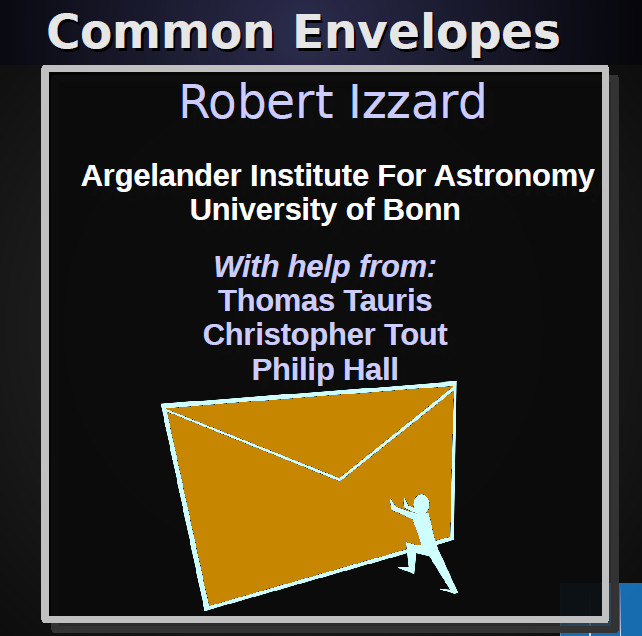 |
I review recent progress on understanding common-envelope evolution with emphasis on its end result, a (possibly bipolar) planetary nebula. Which stars will go into the common-envelope phase? How is it modelled? What is the outcome and will it lead to a planetary nebula? I review both the detailed modelling approach, e.g.through hydrodynamical simulations, and the population/statistical comparison technique. Future prospects will be considered briefly, e.g. CE/PN research including calibration of models to observations through chemical yield comparisons and improved modelling of progenitors and lifetimes.
|
| PDF (17MB) |
| The Origin Of The Elements |
| Inaugural lecture given at the Bonn University Dies Academicus 2011 |
| In just a few thousand years of recorded history, mankind has made great strides in its understanding of the Universe. One of the most fundamental questions we can ask is: what is the origin of the elements that make up every atom in our bodies, of the earth, our sun and all the stars we can see? I will tell the story of the origin of the elements and talk about how much we know and how much remains to be discovered.
|
 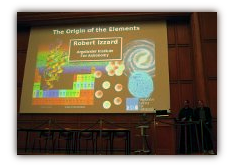 |
| J-type carbon stars |
| Bonn stellar physics group seminar |
| The J stars are 13C rich carbon stars and are not rare (10% of all C-stars!). How they are they formed? What makes the 13C? What about those with silicate emission? What about their odd chemical abundances? Indeed they remain a mystery...
|
 |
| PDF (3.3MB) |
| The Mysterious Barium Stars |
| Invited talk at the UK National Astronomy Meeting 2011, Llandudno, Wales |
 |
The barium stars are G/K giants which contain copious
amounts of barium but are not evolved enough to have made
it themselves. Instead they acquired their heavy metal
from a now dead AGB companion star. Canonical theory
of mass transfer and tidal circularization suggests
that barium stars with periods less than about twenty years
should have circular orbits. That they do not is a serious
problem for our understanding of AGB and/or binary-star physics.
We investigate by simulating populations of Ba stars and
find that our models only match the observed eccentricities
and periods if we introduce some exotic new physics,
for example a stellar kick at the end of the AGB or interaction
with a circumbinary disc. |
| PDF (3.1MB) |
| Mass Transfer in Binary Stars |
| Colloquium given at Lund Observatory, October 2010 |
| Because most stars are in binaries, if we are to understand stars, and hence star clusters, galaxies and the Universe in general, we must understand binaries. How mass and angular momentum are transferred between stars is critical to our understanding of basic stellar evolution as well as exotica such as type Ia supernovae and gamma-ray bursts. |  |
| PDF (4.3MB) |
| Barium Stars Revisited |
| The Asymmetric Planetary Nebulae V conference, Winderemere, UK. With Tyl Dermine and Ross Church. |
 |
A kick of a few km s-1 at the end of the AGB gives the barium stars the eccentricity with which they are observed. I discuss the link between these stars, post-AGB stars and planetary nebulae. Offence warning: curry is mentioned. |
| PDF (1.5MB) |
| Barium Stars Revisited |
| Presented at the 10th Torino Workshop on AGB stars. With Tyl Dermine and Ross Church. |
| An overview of work so far on white dwarf kicks in barium stars. Adding a moderate kick of a few km s-1 gives the barium stars the required eccentricity but problems with common-envelope evolution and (a lack of) orbital shrinkage remain. | 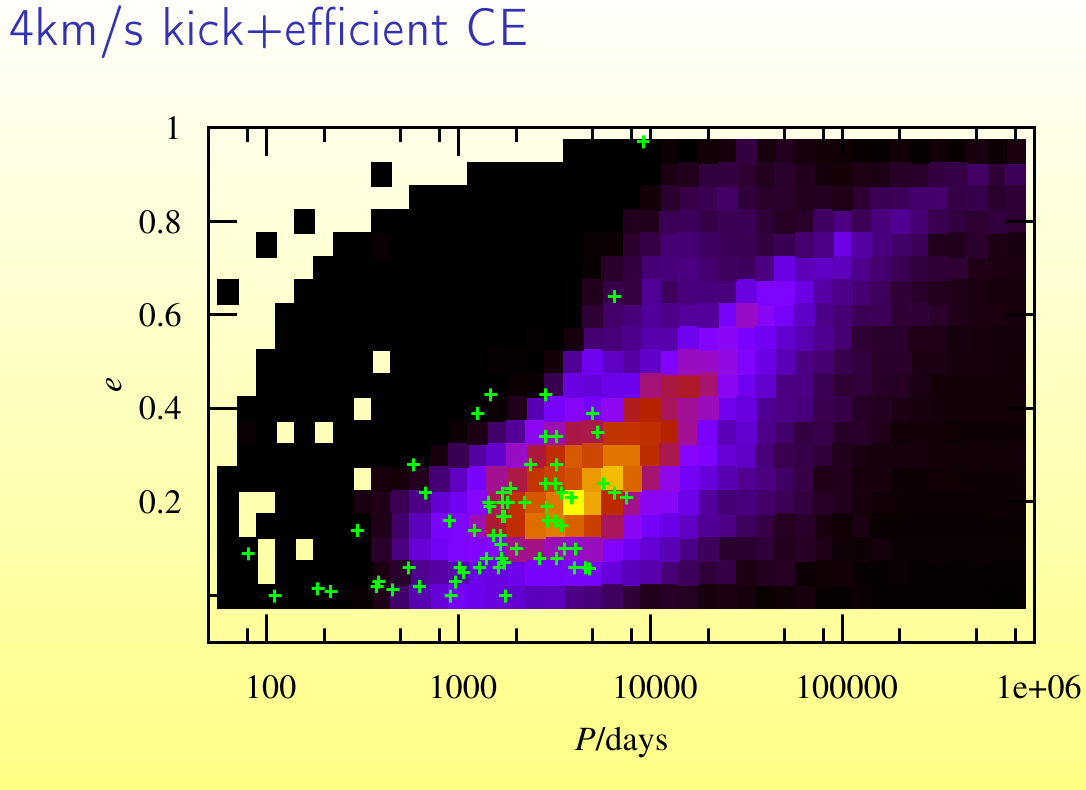 |
| PDF (1.1MB) |
| Chemically Peculiar Stars: The Binary/CEMP Connection |
| Colloquium at Mt. Stromlo Observatory, January 2010 |
 | I discuss the two modes of mass transfer in binaries, wind accretion and Roche-lobe overflow. These are applied to populations of chemically peculiar stars with a focus on the carbon-enhanced metal-poor stars and our recent population models of their progenitors. |
| PDF (1.6MB) |
| Review talk on binary stars |
| Interview for my current position at the AIfA, Bonn |
| Most stars are in binary systems and they are responsible for many of the most important phenomena in astrophysics. I review some of the processes important to binary-star evolution and show some recent results about CEMP stars. |
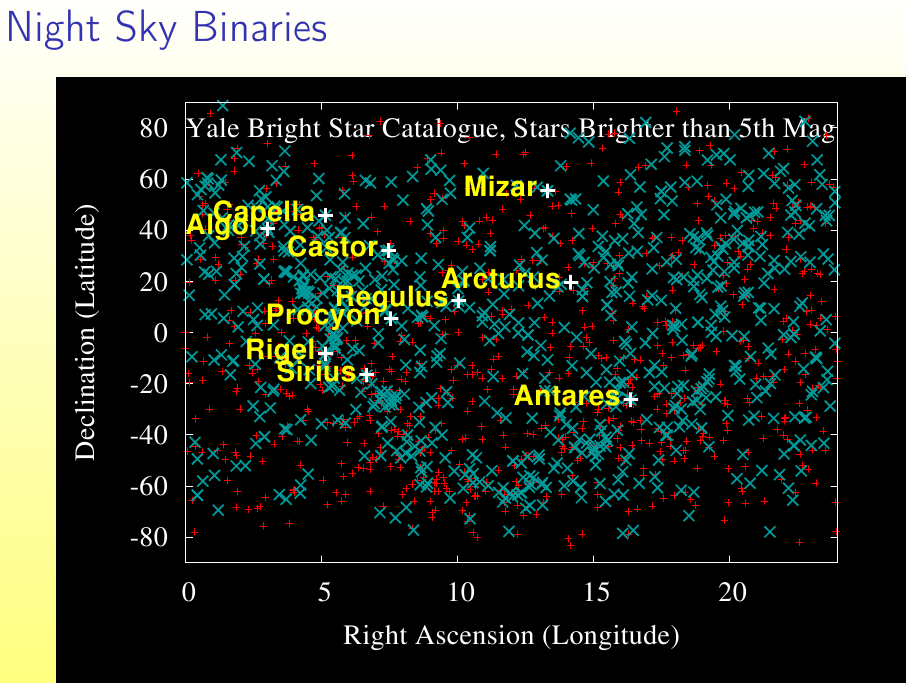 |
| PDF (1.7MB) |
| ULB Binary-star Modelling Effort |
| Contact group (Belgian astronomy) meeting 2009 |
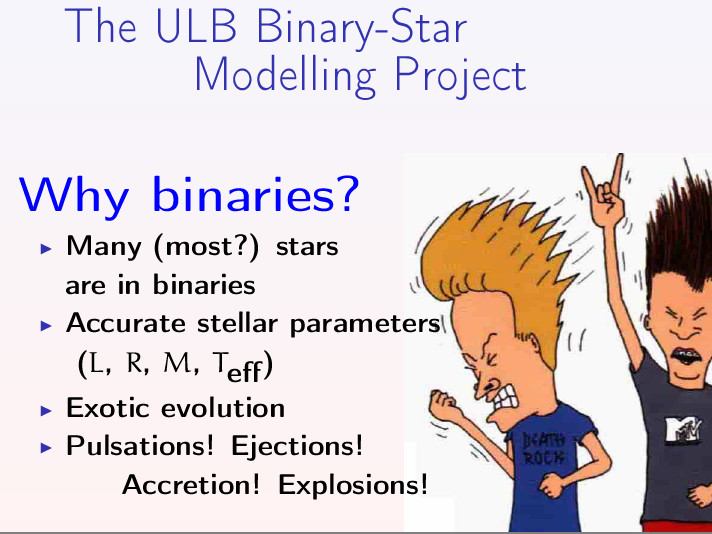 |
In this talk I outline my two-year Marie Curie Intra-European Fellowship project at ULB to create BINSTAR, a full binary-star evolution code for low- and intermediate-mass stellar systems. |
| PDF (463KB) |
| Solving the Century-Old R Star Mystery |
| With Simon Jeffery and John Lattazio |
| The R stars are peculiar K-type giants which show carbon at their surface. They are also all single stars. The evolution of a single star should not pass through such a phase, so I examine the evidence for a binary merger origin of the R stars. With the aid of population synthesis models various channels for R star formation are examined. The most likely is the merger of a helium white dwarf with a red giant. |
 |
| PDF (3.6MB) |
| Simulating Populations of CEMPs |
Presented at "The Origin of the Elements Heavier than Iron" in honour of the 70th birthday of Roberto Gallino
With Evert Glebbeek, Onno Pols and Richard Stancliffe |
 |
I present preliminary results of our CEMP population synthesis models. It is already clear that efficient third dredge up is requied down to the very lowest masses, in contradiction of previous stellar evolution models. Nitrogen also seems to present difficulties. |
| PDF (1MB) |
| Single and Binary Star Population Synthesis (an overview) |
| First SINS summer school |
| The first lecture deals with the theory behind binary population synthesis, introducing necessary concepts such as initial distribution functions and how to count stars. JL didn't like it, but the audience did! The second lecture describes some of the available computer codes and some of my (then) recent results. |
 |
| Part 1 (1.7MB PDF), Part 2 (3.2M PDF) |
| Binary AGB Nucleosynthesis |
| Presented at Asymmetric Planetary Nebulae IV, La Palma, 2007 |
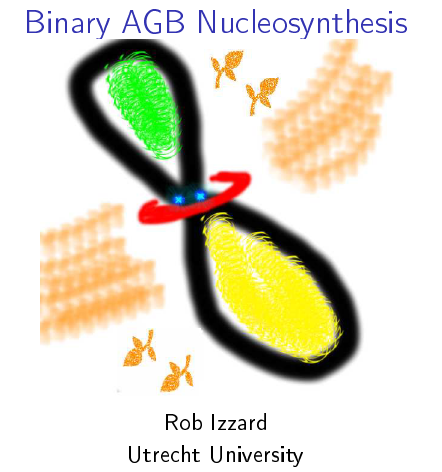 |
The effect of duplicity is often ignored when comparing AGB, post-AGB and planetary nebula chemical abundances to stellar evolution models. I show how interaction with a binary companion truncates the TPAGB evolutionary phase and, on average, reduces the production of various elements including carbon and nitrogen. |
| PDF (488KB) |
| Reaction rates/NeNa/MgAl |
Nuclei in the Cosmos 2006
With Maria Lugaro, Christian Iliadis and Amanda Karakas |
| We present preliminary results of a project which aims to quantify the uncertainties due to errors in nuclear reaction rates in the production of sodium, neon, magnesium and aluminium in massive AGB stars. In particular, the 22Ne(p,γ)23Na rate is highly uncertain and leads to significant yield variation. |
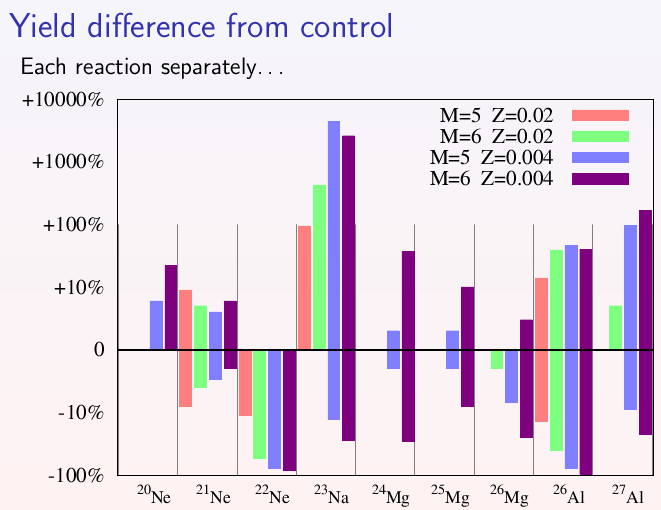 |
| PDF (385KB) |
| Binary Star Nucleosynthesis |
| Colloquium talk in Nijmegen, 2006 |
 |
I present an overview of nucleosynthesis in stars and the effect of duplicity on stellar yields. |
| PDF (0.8MB) |
| Synthetic SAGB models |
Torino 8, Granada
With Arend-Jan Poelarends |
| The chemical yields and properties from super-AGB stars are very uncertain at present. We estimate the number of pulses and chemical yields by incorporation of SAGB star detailed model results into my synthetic AGB code. A major uncertainty is the mass-loss rate which can change the number of thermal pulses by orders of magnitude. |
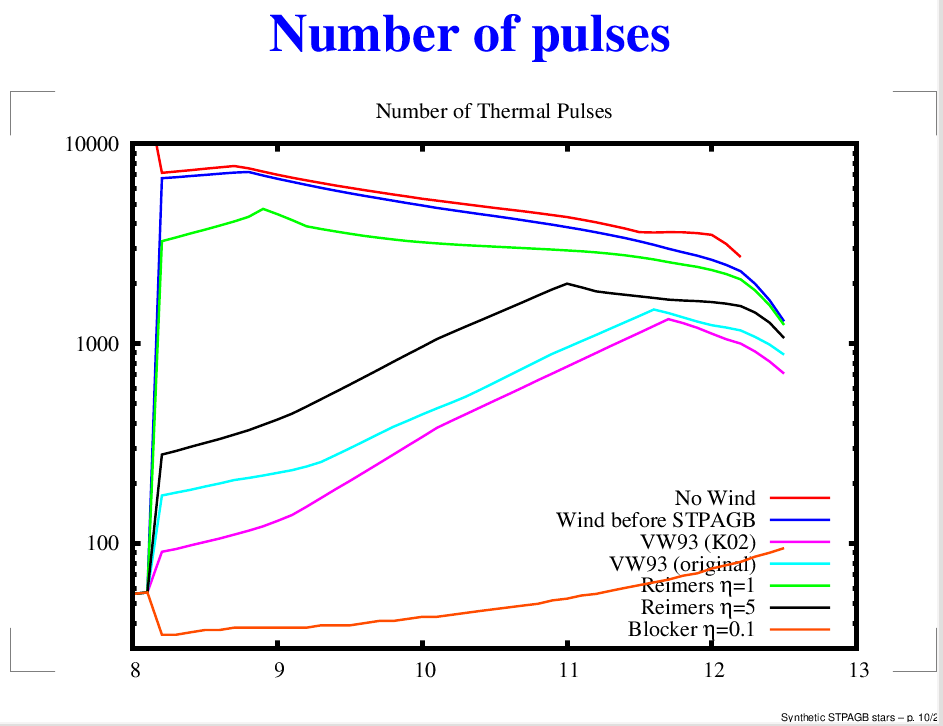 |
| PDF (624KB) |
| Reaction rates/NeNa/MgAl |
| Brussels 22nd astronuclear meeting |
| Preliminary results from the Ne/Na/Mg/Al uncertainty project. |
| PDF (443KB) |
| BSE is not just for cows (it's for GCE too) |
| Presented in many places: |
 |
A talk about binary stars, chemical yields, chemical evolution of the early Galaxy and population synthesis. |
| Utrecht Version PDF (1.1MB) • Preston version (1.2MB) |
| Initial Distributions of Binary Stars and Chemical Yields |
| Nucleosynthesis In Binary Stars workshop at the Lorentz Centre, Leiden |
| A brief talk to demonstrate the dependence of binary stellar yields on initial mass functions and the separation distribution. |
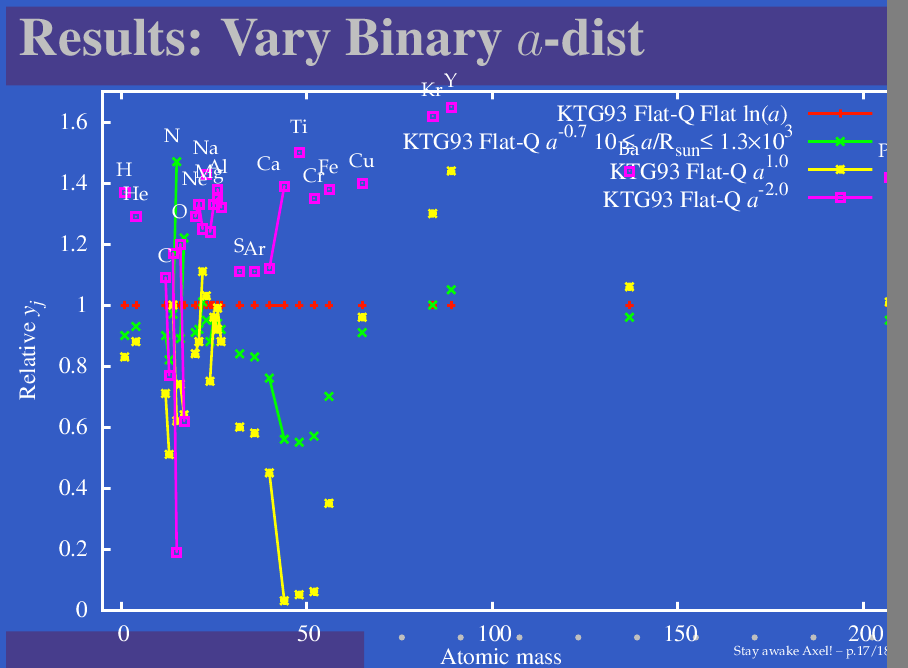 |
| PDF (217KB) |
| Population Nucleosynthesis and rapid He-burning |
| Halifax |
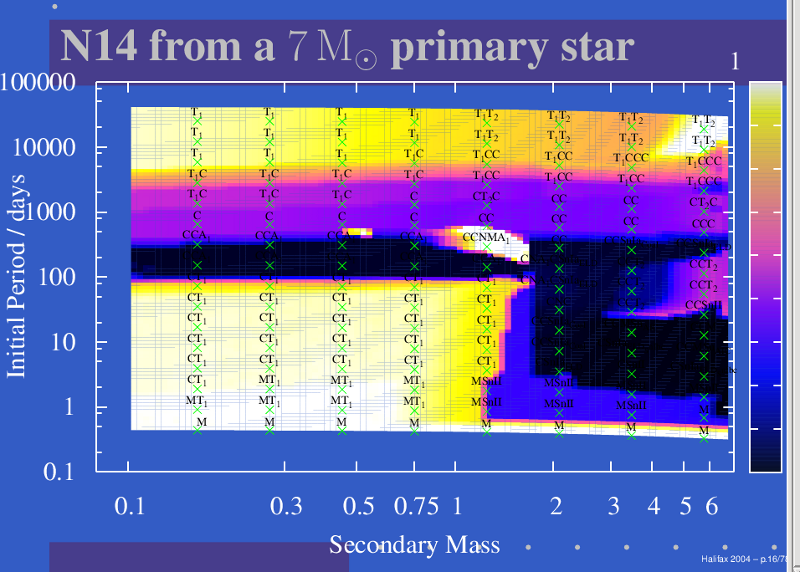 |
I present an attempt a rapid helium burning in a synthetic AGB model. I never got it to work... but I think I could now! |
| PDF (2.4MB) |
| Binary Carbon Stars |
|
| There are many dim carbon stars which, according to standard single-star evolution, should not exist. I estimate the number of these by a population synthesis technique and find an excellent match between the carbon-star luminosity functions I predict for the Magellanic Clouds and the observed distributions. |
 |
| PDF (787KB) |

